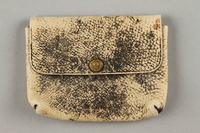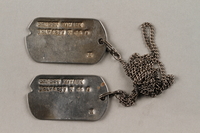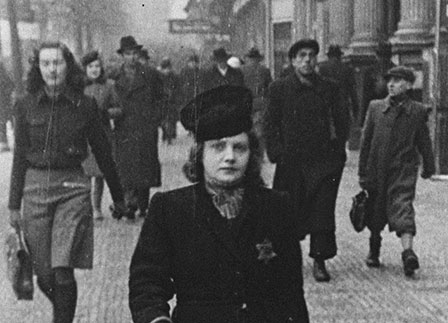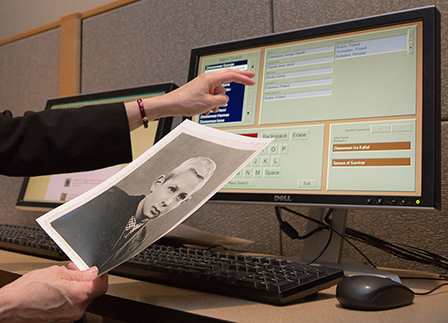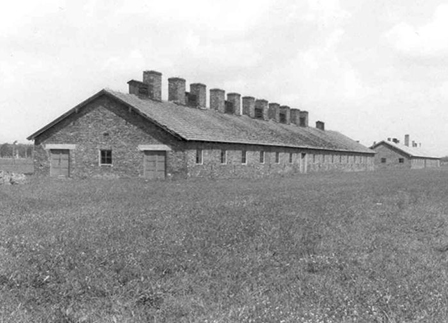Overview
- Description
- The Kovary and Neuhaus families papers consist of biographical materials, correspondence, and photographs related to the experiences of the Kovary and Neuhaus families’ pre-World War II experiences in Czechoslovakia and Germany, respectively; their emigration due to antisemitic persecution; their immigration to the United States and Great Britain; and subsequent experiences during World War II and in the immediate post-war years. The collection also includes restitution files documenting Ernest Kovary’s work assisting Holocaust survivors in filing restitution claims.
Neuhaus family materials include biographical materials, correspondence, and photographs. Biographical materials document Ingrid’s immigration to Great Britain on a Kindertransport in 1939 and include her wartime diaries and a memoir she wrote in the 1990s. Correspondence files include Ingrid’s correspondence with her parents, who were killed in the Holocaust. This series also includes extensive pre-war, wartime, and post-war photographs of Ingrid Neuhaus Kovary and her family.
Kovary family materials include biographical materials, correspondence, photographs, and printed materials documenting the Kovary family before, during, and after World War II. Biographical materials include birth, marriage, and death certificates; immigration documents; and documents pertaining to Olivio Kovary's repeated attempts to certify his American citizenship. Family correspondence primarily dates from the World War II years and includes many letters written in Esperanto. Photographs depict much of the Kovary family. Printed materials document the family’s interest in Esperanto.
Restitution files include correspondence, forms, and notes documenting Ernest Kovary’s work as a notary public assisting Holocaust survivors in filing restitution claims. - Date
-
inclusive:
1890-2013
- Credit Line
- United States Holocaust Memorial Museum Collection, Gift of Myra Kovary and Vally Kovary
United States Holocaust Memorial Museum Collection, Gift of Vally Kovary
United States Holocaust Memorial Museum Collection, Gift of Myra Kovary and Vally Kovary. - Collection Creator
- Kovary family
Neuhaus family - Biography
-
Olivio Kovary (1890-1976) was born Olivio Kovari on November 4, 1890 in Baltimore, MD, where his parents Alexander and Josefine Berkovits Kovari had arrived earlier the same year. Olivio’s birth was not registered with the proper authorities in Baltimore and a birth certificate was not issued. When Olivio was one year old, his mother became very ill and the family returned to their hometown of Galanta in what was at that time the Austro-Hungarian Empire. Josefine died soon after her return to Europe and Alexander Kovari remarried.
Olivio married Esther Fuchs (1897-1988), and the couple had two sons in Bratislava, Czechoslovakia: Ernö (Ernest, 1919-2013, b. April 2, 1919) and Tibor (Tom, 1920-1988, b. June 23, 1920). In 1920 Olivio, who always regarded himself an American citizen, wrote to the US Embassy in Budapest requesting an American passport and the recognition of his citizenship, but he was refused. In 1936 he received another negative response from the US Embassy, but he was encouraged to apply for an immigration visa. Olivio, Esther, Ernö, and Tibor registered in the American Consulate for immigration.
The Kovary family considered themselves to be internationalists. Ernö and Tibor were recognized as being the first native speakers of Esperanto in the world. Esperanto is the most widely spoken constructed international auxiliary language. Its name derives from Doktoro Esperanto, the pseudonym under which L. L. Zamenhof published the first book detailing Esperanto, the Unua Libro, in 1887. The word esperanto means "one who hopes" in the language itself. Zamenhof's goal was to create an easy and flexible language that would serve as a universal second language to foster peace and international understanding. Esperanto has had continuous usage by a community estimated at between 100,000 and 2 million speakers for over a century, and approximately one thousand native speakers. The Kovarys were multilingual, speaking Esperanto and Hungarian (Olivio and Esther’s native tongue) at home and Slovak outside of the home. The boys attended German schools, took English and French classes, and learned Hebrew as part of their religious studies in a cheder.
Already in 1934 Olivio pulled his sons out of school and started to teach them the fur trade in anticipation of the imminent immigration. As these plans did not pan out, Tibor attended a vocational school in Bratislava and graduated in 1937.
Tibor and Ernö were excellent athletes and belonged to the Bar Kochba Jewish Sports Club. They were recognized as national gymnastics champions of Czechoslovakia. They were also among the first pupils of Imi Lichtenfeld, who created Krav Maga, at which the brothers excelled. They assisted Mr. Lichtenfeld in developing many of the skills that Lichtenfeld incorporated into the hand-to-hand combat system that is used by the Israeli Army.
On September 2, 1939, the day after the German invasion of Poland, two local Nazi sympathizers (whom Tibor and Ernö believed to be members of the Hitler youth) harassed the two brothers in the street of Bratislava, inquiring whether they were Jewish. A fistfight began among the four, and excellent athletes Tibor and Ernö defeated their attackers. Slovakia under Jozef Tiso aligned itself with Nazi Germany, and Tibor and Ernö were arrested and accused of attacking innocent passersby. Their father was also arrested, and the Kovary store was looted. On December 12, 1939 the family fled Slovakia, crossing the Hungarian border illegally without proper documents. They stayed in Budapest illegally waiting for their US immigration visa, and on February 20, 1940 the family boarded the SS Conte di Savoia in Genoa and left for New York.
In January 1943 Tom (who changed his name from Tibor) enlisted in the US Army, trained at Camp Ritchie, and served in the Army intelligence. His brother Ernest (who had changed his name from Ernö) also enlisted and was posted in the European theater. On June 6, 1944 Ernest was part of the American forces landing in Normandy. During their military service, the brothers corresponded constantly with each other and with their parents. They initially wrote their letters in Esperanto, but after D-Day they had to write in English to accommodate military censors. After the war Ernest served with the U.S. Department of Justice as a translator in preparation for the Nuremberg Trials. He tried to find members of the family, visited Bratislava, and was able to locate one first cousin, Herta Fuchs, who survived Auschwitz.
Ernest later became a notary public and specialized in assisting Holocaust survivors in their attempts to gain restitution. Ernest Kovary lived with his parents for most of life and reunited with Alice “Lizzi” Reiss, a widowed childhood friend from Bratislava, in 1996. Alice died in 2009.
Tom Kovary studied languages at Ohio State University and married Ingrid Neuhaus on July 30, 1950 in Columbus, OH. They had two daughters: Myra, b. 1952 and Vally b. 1955. The family moved to Ithaca, New York in 1953, where Tom began academic studies towards a Ph.D. in Linguistics at Cornell University. In 1959 he became a professor of Spanish and Linguistics at the State University of New York at Cortland, NY. He retired in 1985 and died three years later of cancer. Tom Kovary was devoted to Jewish traditions and observances. He was active in various Jewish organizations.
Olivio Kovary died in May 1976 at age 85 in New York City. Esther Kovary died there as well, in July 1988 at the age of 91.
Ingrid Neuhaus (1921-2009) was born on August 2, 1921 in Hamburg, Germany as the oldest of three children of Julius Neuhaus and Marie Eisner Neuhaus. Julius was a prosperous merchant of leather goods and hides and Marie was in charge of the house and the children: Ingrid, Annelore (b. September 23, 1923), and Hans (b. July 20, 1925). The Neuhaus family were “progressive” Jews and joined a Reform synagogue in 1933. Julius had worked in Argentina, returned to Germany to serve during WWI, and had an import/export business that flourished until 1929, but then matters declined.
In 1933 Julius’ business was confiscated by the Nazis, and the family had to move from their comfortable apartment when unable to pay the rent. Marie started selling housewares with the help of her children who distributed the goods by bicycle. Wealthy relatives sent a check every month to cover the rent. Julius was a decorated WWI veteran and could not accept the reality of Nazi policies towards the Jews. In 1935, anti-Semitic laws prohibit the family’s housekeeper and nanny, Agnes Netzband Roepcke, to continue working for the family. Agnes disobeyed the new rules and remained in touch with the family.
Ingrid excelled in school and attended “Realschule” until Nazi laws forced her out in 1937. She transferred to a Jewish school of Home Economics, learned kosher cooking, and graduated in 1938. Ingrid became very active in the Jewish sports club “der Schild” and excelled at field hockey and at track and field in the 100 meter dash. Ingrid wanted to continue her education after graduation from the cooking school, but Nazi laws barred her from German schools. She worked for six months as a nanny for a Jewish family in Berlin and spent time with her maternal grandparents there. She returned to Hamburg in October 1938.
In the late 1930s, Marie registered her family for immigration to the United States, but received a very high number. During Kristallnacht, November 9, 1938, Ingrid was sick in bed, her father pretended to be ill too, and the family was surprisingly not harassed by the Nazis. Marie was able to arrange for Annelore and Hans to leave Germany on a Kindertransport on January 27, 1939, but a paperwork problem delayed Ingrid until February 2. Ingrid got a job living with a Jewish family in London and taking care of their children. She tried desperately but unsuccessfully to arrange for immigration visas for her parents. During the London Blitz, Ingrid was evacuated to Oxford and found work as a seamstress. She tried to attend lectures at the university, but regulations governing enemy aliens made it impossible. Ingrid received letters from her parents via Switzerland until their deportation from Hamburg on November 8, 1941 to the Minsk ghetto in Belorussia. Their former housekeeper witnessed their deportation and later reported witnessing the train’s last car, loaded with the personal belongings of the passengers, being left behind at the station.
Ingrid’s siblings Annelore (later Anne) and Hans (later Tony) attended college. In 1942 Ingrid got a job as a lab technician but this work strained her eyes and after a while she was forced to stop. For six months Ingrid was unemployed while she received medical treatments for her eyes, but an American soldier helped her survive by suppling her items that were hard to come by in wartime England. Ingrid then began secretarial school. After the war, Ingrid and Anne signed up with Civil Censorship Division of the US War Department. For almost two years Ingrid worked in Germany, and she visited her former nanny in Hamburg. In 1947 her immigration visa for the US finally came through. She was sponsored by the parents of her friend, Irma van der Porten, arrived in Oxford, Ohio, and then moved to Columbus in 1949. She worked as a clerk and sat in on classes at the Ohio State University. Ingrid met Tom Kovary at a Hillel dance at the university, and they married on July 30, 1950. Their older daughter Myra was born in 1952. A year later the family moved to Ithaca, NY, where their younger daughter Vally was born in 1955.
In 1957 Ingrid became a Lecturer in German in the Division of Modern Language and Literature at Cornell University. She continued to take various university courses throughout her adult life. Without having ever received a bachelor’s degree, she applied, studied for, and received her Master of Arts degree in Education from Cornell University in 1967.
Tom Kovary died on March 15, 1988. Ingrid continued to reside in Ithaca, NY close to her two daughters and her two grandchildren, Arly and Shoshana Kamholtz. She suffered a major stroke in April 2009 and died in September 2009.
Physical Details
- Genre/Form
- Correspondence. Photographs. Diaries.
- Extent
-
21 boxes
8 oversize boxes
11 oversize folders
7 book enclosures
- System of Arrangement
- The Kovary and Neuhaus families papers are arranged as three series:
Series 1: Neuhaus family papers, 1890-2010
Subseries 1: Neuhaus family biographical materials, 1921-2010
Subseries 2: Neuhaus family correspondence, 1908-1999
Subseries 3: Neuhaus family photographs, 1890-1965
Series 2: Kovary family papers, 1890-2013
Subseries 1: Kovary family biographical materials, 1894-2013
Subseries 2: Kovary family correspondence, 1909-2011
Subseries 3: Kovary family photographs, 1890-2009
Subseries 4: Kovary family printed materials, 1906-2004
Series 3: Restitution papers, 1941-2010
Rights & Restrictions
- Conditions on Access
- There are no known restrictions on access to this material.
- Conditions on Use
- Donor retains copyright for this collection.
Material(s) in Series 3 are protected by copyright and/or related rights, or contain sensitive personal information. Users may not share with a third party material that contains identifiable information of an individual (e.g., names, dates of birth, social security numbers, bank account information from the last 50 years, etc…) until 50 years after the last date in the file.
The user is solely responsible for their use of this material.
Keywords & Subjects
Administrative Notes
- Holder of Originals
-
United States Holocaust Memorial Museum
- Legal Status
- Permanent Collection
- Provenance
- Myra and Vally Kovary donated the Kovary and Neuhaus families papers to the United States Holocaust Memorial Museum in 2009, 2010, 2018, and 2019. Accessions cataloged as 2009.364.1, 2010.519.1, 2018.528.1, and 2019.199.1 have been incorporated into this collection.
- Primary Number
- 2009.364.15
- Record last modified:
- 2024-01-04 09:49:14
- This page:
- http://collections.ushmm.org/search/catalog/irn714679
Additional Resources
Download & Licensing
- See Rights and Restrictions
- Terms of Use
- This record is not digitized and cannot be downloaded online.
In-Person Research
- Not Available for Research: Out for Digitization
- Plan a Research Visit
-
Request in Shapell Center Reading Room
Bowie, MD
Contact Us
Also in Kovary and Neuhaus families collection
The Kovary and Neuhaus families collection includes medals, ribbons, pins, a leather wallet, a leather portfolio, a set of silver ice cream spoons, and family papers documenting the Holocaust-era experiences of the Kovary family from Bratislava and the Neuhaus family from Hamburg.
Date: 1890-2013
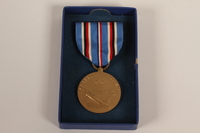
US Army American Campaign Medal and ribbon bar with presentation box awarded to a Czech Jewish refugee
Object
Bronze medal with ribbon, ribbon bar, and presentation box issued to Tom (Tibor) Kovary for service in the United States Army from 1943-1946. On September 2, 1939, 19 year old Tibor Kovari and his 20 year old brother, Erno, were attacked on the street for being Jewish by Nazi sympathizers in their hometown, Bratislava, Czechoslovakia. They fought back, put their attackers in the hospital, and were arrested, along with their father, Olivio. The incident received such widespread publicity that the authorities advised them to flee for fear of retaliation. They illegally crossed the border into Hungary, where they obtained visas for the US, arriving in New York on February 29, 1940. Both brothers joined the US Army: Tom was in Military Intelligence stateside; Ernest in combat, landing with the infantry on D-Day. He searched for surviving relatives, but found only one cousin, a survivor of Auschwitz death camp.
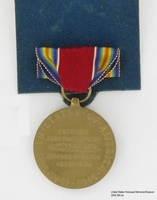
US Army Victory Medal, two ribbon bars and presentation box awarded to a Czech Jewish refugee
Object
Victory Medal, ribbon bars, and box issued to Tom (Tibor) Kovary for service in the United States Army from 1943-1946. On September 2, 1939, nineteen year old Tibor Kovari and his twenty year old brother, Erno, were attacked on the street for being Jewish by Nazi sympathizers in their hometown, Bratislava, Czechoslovakia. They fought back, put their attackers in the hospital, and were arrested, along with their father, Olivio. The incident received such widespread publicity that the authorities advised them to flee for fear of retaliation. They illegally crossed the border into Hungary, where they obtained visas for the US, arriving in New York on February 29, 1940. Both brothers joined the US Army: Tom was in Military Intelligence stateside; Ernest in combat, landing with the infantry on D-Day. He searched for surviving relatives, but found only one cousin, a survivor of Auschwitz death camp.
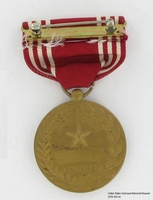
US Army Good Conduct Medal, 3 ribbon bars, and 3 ribbons awarded to a Czech Jewish refugee
Object
Good Conduct Medal, three red and white ribbon bars, and 3 replacement ribbons issued to Tom (Tibor) Kovary for service in the United States Army from 1943-1946. On September 2, 1939, 19 year old Tibor Kovari and his 20 year old brother, Erno, were attacked on the street for being Jewish by Nazi sympathizers in their hometown, Bratislava, Czechoslovakia (Slovakia). They fought back, put their attackers in the hospital, and were arrested, along with their father, Olivio. The incident received such widespread publicity that the authorities advised them to flee for fear of retaliation. They illegally crossed the border into Hungary, where they obtained visas for the US, arriving in New York on February 29, 1940. Both brothers joined the US Army: Tom was in Military Intelligence stateside; Ernest in combat, landing with the infantry on D-Day. He searched for surviving relatives, but found only one cousin, a survivor of Auschwitz death camp.
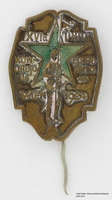
World Congress of Esperanto stickpin with an image of soldier upon a green star owned by a Czech Jewish refugee
Object
Commemorative pin from the World Congress of Esperanto in Vienna, Austria, in 1924, owned by Tom (Tibor) Kovary. On September 2, 1939, nineteen year old Tibor Kovari and his twenty year old brother, Erno, were attacked on the street for being Jewish by Nazi sympathizers in their hometown, Bratislava, Czechoslovakia. They fought back, put their attackers in the hospital, and were arrested, along with their father, Olivio. The incident received such widespread publicity that the authorities advised them to flee for fear of retaliation. They illegally crossed the border into Hungary, where they obtained visas for the US, arriving in New York on February 29, 1940. Both brothers joined the US Army: Tom was in Military Intelligence stateside; Ernest in combat, landing with the infantry on D-Day. He searched for surviving relatives, but found only one cousin, a survivor of Auschwitz death camp.
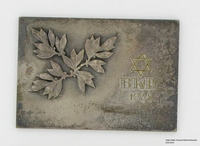
Bar Kochba Jewish Sports Club metal plaque with a Star of David owned by a Czech Jewish refugee
Object
Commemorative plaque from the Bar Kochba Jewish sports club awarded to Tom T. Kovary in Bratislava, Czechoslovakia, on January 9, 1938. On September 2, 1939, nineteen year old Tibor Kovari and his twenty year old brother, Erno, were attacked on the street for being Jewish by Nazi sympathizers in Bratislava. They fought back, put their attackers in the hospital, and were arrested, along with their father, Olivio. The incident received such widespread publicity that the authorities advised them to flee for fear of retaliation. They illegally crossed the border into Hungary, where they obtained visas for the US, arriving in New York on February 29, 1940. Both brothers joined the US Army: Tom was in Military Intelligence stateside; Ernest in combat, landing with the infantry on D-Day. He searched for surviving relatives, but found only one cousin, a survivor of Auschwitz death camp.

Bar Kochba Jewish Sports Club (BKB) stickpin with blue enamel decoration owned by a Czech Jewish refugee
Object
Pin from the Bar Kochba Jewish sports club (BKB) , in Bratislava, Czechoslovakia, received by Tom T. Kovary, prior to emigration. On September 2, 1939, nineteen year old Tibor Kovari and his twenty year old brother, Erno, were attacked on the street for being Jewish by Nazi sympathizers in Bratislava. They fought back, put their attackers in the hospital, and were arrested, along with their father, Olivio. The incident received such widespread publicity that the authorities advised them to flee for fear of retaliation. They illegally crossed the border into Hungary, where they obtained visas for the US, arriving in New York on February 29, 1940. Both brothers joined the US Army: Tom was in Military Intelligence stateside; Ernest in combat, landing with the infantry on D-Day. He searched for surviving relatives, but found only one cousin, a survivor of Auschwitz death camp.
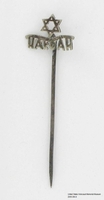
Hakoah Sports Club stickpin with a Star of David owned by a Czech Jewish refugee
Object
Pin from the Hakoah sports club that belonged to Tom T. Kovary, prior to emigration from Bratislava, Czechoslovakia. On September 2, 1939, nineteen year old Tibor Kovari and his 20 year old brother, Erno, were attacked on the street for being Jewish by some Nazi sympathizers in their hometown, Bratislava, Czechoslovakia. They fought back and put their attackers in the hospital and were arrested, along with their father, Olivio. The incident received such widespread publicity that the authorities advised them to flee for fear of retaliation. They illegally crossed the border into Hungary, where they obtained visas for the United States, arriving in New York on February 29, 1940. Both brothers joined the US Army during the war: Tom was in Military Intelligence stateside; Ernest in combat, landing with the infantry on D-Day. He searched for surviving relatives, but found only one cousin, a survivor of Auschwitz death camp.
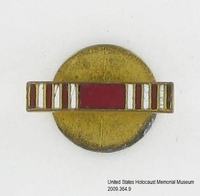
US Army Good Conduct lapel button awarded to a Czech Jewish refugee
Object
Lapel button issued to Tom T. Kovary for service in the United States Army, from 1943-1946, during World War II. On September 2, 1939, nineteen year old Tibor Kovari and his twenty year old brother, Erno, were attacked on the street for being Jewish by Nazi sympathizers in their hometown, Bratislava, Czechoslovakia. They fought back, put their attackers in the hospital, and were arrested, along with their father, Olivio. The incident received such widespread publicity that the authorities advised them to flee for fear of retaliation. They illegally crossed the border into Hungary, where they obtained visas for the US, arriving in New York on February 29, 1940. Both brothers joined the US Army: Tom was in Military Intelligence stateside; Ernest in combat, landing with the infantry on D-Day. He searched for surviving relatives, but found only one cousin, a survivor of Auschwitz death camp.
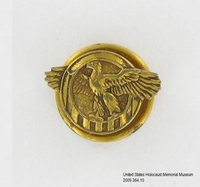
US Army Honorable Service lapel button awarded to a Czech Jewish refugee
Object
Lapel button issued to Tom T. Kovary for service in the United States Army, from 1943-1946, during World War II. On September 2, 1939, nineteen year old Tibor Kovari and his twenty year old brother, Erno, were attacked on the street for being Jewish by Nazi sympathizers in their hometown, Bratislava, Czechoslovakia. They fought back, put their attackers in the hospital, and were arrested, along with their father, Olivio. The incident received such widespread publicity that the authorities advised them to flee for fear of retaliation. They illegally crossed the border into Hungary, where they obtained visas for the US, arriving in New York on February 29, 1940. Both brothers joined the US Army: Tom was in Military Intelligence stateside; Ernest in combat, landing with the infantry on D-Day. He searched for surviving relatives, but found only one cousin, a survivor of Auschwitz death camp.

Bar Kochba Jewish Sports Club stickpin (BKB) with blue enamel decoration owned by a Czech Jewish refugee to the US
Object
Stickpin from the Bar Kochba Jewish sports club in Bratislava, Czechoslovakia, received by Tom (Tibor) Kovary, prior to his emigration to the United States. On September 2, 1939, nineteen year old Tibor Kovari and his twenty year old brother, Erno, were attacked on the street for being Jewish by Nazi sympathizers in Bratislava. They fought back, put their attackers in the hospital, and were arrested, along with their father, Olivio. The incident received such widespread publicity that the authorities advised them to flee for fear of retaliation. They illegally crossed the border into Hungary, where they obtained visas for the US, arriving in New York on February 29, 1940. Both brothers joined the US Army: Tom was in Military Intelligence stateside; Ernest in combat, landing with the infantry on D-Day. He searched for surviving relatives, but found only one cousin, a survivor of Auschwitz death camp.
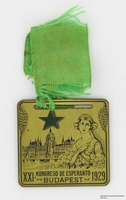
World Congress of Esperanto medallion with an image of woman and a view of Budapest owned by a Czech Jewish refugee
Object
Commemorative medal from the World Congress of Esperanto in Budapest, Hungary, in 1929, attended by Tom (Tibor) Kovary with his family. On September 2, 1939, nineteen year old Tibor Kovari and his twenty year old brother, Erno, were attacked on the street for being Jewish by Nazi sympathizers in Bratislava. They fought back, put their attackers in the hospital, and were arrested, along with their father, Olivio. The incident received such widespread publicity that the authorities advised them to flee for fear of retaliation. They illegally crossed the border into Hungary, where they obtained visas for the US, arriving in New York on February 29, 1940. Both brothers joined the US Army: Tom was in Military Intelligence stateside; Ernest in combat, landing with the infantry on D-Day. He searched for surviving relatives, but found only one cousin, a survivor of Auschwitz death camp.
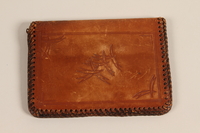
Brown leather wallet with laced edges used by a Czech Jewish refugee during his service in the US Army
Object
Wallet and passport cover used by Tom T. Kovary while a soldier in the United States Army from 1943-1946. On September 2, 1939, nineteen year old Tibor Kovari and his twenty year old brother, Erno, were attacked on the street for being Jewish by Nazi sympathizers in Bratislava. They fought back, put their attackers in the hospital, and were arrested, along with their father, Olivio. The incident received such widespread publicity that the authorities advised them to flee for fear of retaliation. They illegally crossed the border into Hungary, where they obtained visas for the US, arriving in New York on February 29, 1940. Both brothers joined the US Army: Tom was in Military Intelligence stateside; Ernest in combat, landing with the infantry on D-Day. He searched for surviving relatives, but found only one cousin, a survivor of Auschwitz death camp.
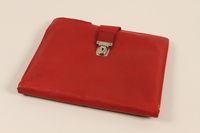
Red leather portfolio used by a Czech Jewish refugee
Object
Red leather notebook that belonged to Tom (Tibor) Kovary. On September 2, 1939, nineteen year old Tibor Kovari and his twenty year old brother, Erno, were attacked on the street for being Jewish by Nazi sympathizers in their hometown, Bratislava, Czechoslovakia (Slovakia). They fought back, put their attackers in the hospital, and were arrested, along with their father, Olivio. The incident received such widespread publicity that the authorities advised them to flee for fear of retaliation. They illegally crossed the border into Hungary, where they obtained visas for the US, arriving in New York on February 29, 1940. Both brothers joined the US Army: Tom was in Military Intelligence stateside; Ernest in combat, landing with the infantry on D-Day. He searched for surviving relatives, but found only one cousin, a survivor of Auschwitz death camp.
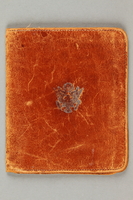
Document holder
Object
Brown leather bifold document holder with plastic covers inside. The wallet may have contained an ID card from the Office of Military Government for Germany (U.S) issued on 9 March 1946 to Ernest Kovary.
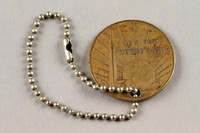
Social Security identification tag
Object
Round metal Social Security tag belonging to Ernest Kovary. The opposite side has an image of the New York World's Fair.
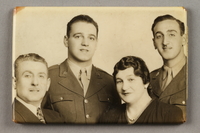
Pocket mirror with photographic image
Object
Pocket mirror with a photographic image of the Kovary family ca. 1945 on the other side.

Silver ice cream serving spoon with floral engraving saved by young German Jewish refugee
Object
Silver ice cream spoon from a set of twelve brought by Ingrid Neuhaus, 18, when she was sent for safety from Hamburg, Germany, to Great Britain in Feburary 1939. She joined her younger siblings Annelore and Hans who had been sent on the Kindertransport in January. This set of spoons was the only valuable item she was able to take out of Germany.
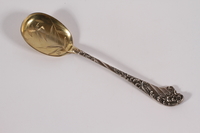
Silver ice cream spoon with floral engraving saved by young German Jewish refugee
Object
Silver ice cream spoon from a set of twelve brought by Ingrid Neuhaus, 18, when she was sent for safety from Hamburg, Germany, to Great Britain in Feburary 1939. She joined her younger siblings Annelore and Hans who had been sent on the Kindertransport in January. This set of spoons was the only valuable item she was able to take out of Germany.
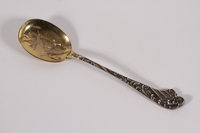
Silver ice cream spoon with floral engraving saved by young German Jewish refugee
Object
Silver ice cream spoon from a set of twelve brought by Ingrid Neuhaus, 18, when she was sent for safety from Hamburg, Germany, to Great Britain in Feburary 1939. She joined her younger siblings Annelore and Hans who had been sent on the Kindertransport in January. This set of spoons was the only valuable item she was able to take out of Germany.
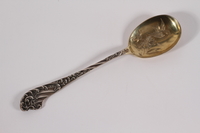
Silver ice cream spoon with floral engraving saved by young German Jewish refugee
Object
Silver ice cream spoon from a set of twelve brought by Ingrid Neuhaus, 18, when she was sent for safety from Hamburg, Germany, to Great Britain in Feburary 1939. She joined her younger siblings Annelore and Hans who had ben sent the Kindertransport in January. This set of spoons was the only valuable item she was able to take out of Germany.
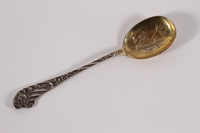
Silver ice cream spoon with floral engraving saved by young German Jewish refugee
Object
Silver ice cream spoon from a set of twelve brought by Ingrid Neuhaus, 18, when she was sent for safety from Hamburg, Germany, to Great Britain in Feburary 1939. She joined her younger siblings Annelore and Hans who had been sent on the Kindertransport in January. This set of spoons was the only valuable item she was able to take out of Germany.
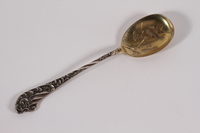
Silver ice cream spoon with floral engraving saved by young German Jewish refugee
Object
Silver ice cream spoon from a set of twelve brought by Ingrid Neuhaus, 18, when she was sent for safety from Hamburg, Germany, to Great Britain in Feburary 1939. She joined her younger siblings Annelore and Hans who had been sent on the Kindertransport in January. This set of spoons was the only valuable item she was able to take out of Germany.
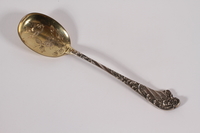
Silver ice cream spoon with floral engraving saved by young German Jewish refugee
Object
Silver ice cream spoon from a set of twelve brought by Ingrid Neuhaus, 18, when she was sent for safety from Hamburg, Germany, to Great Britain in Feburary 1939. She joined her younger siblings Annelore and Hans who had been sent on the Kindertransport in January. This set of spoons was the only valuable item she was able to take out of Germany.
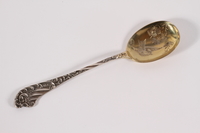
Silver ice cream spoon with floral engraving saved by young German Jewish refugee
Object
Silver ice cream spoon from a set of twelve brought by Ingrid Neuhaus, 18, when she was sent for safety from Hamburg, Germany, to Great Britain in Feburary 1939. She joined her younger siblings Annelore and Hans who had been sent on the Kindertransport in January. This set of spoons was the only valuable item she was able to take out of Germany.
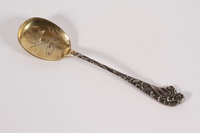
Silver ice cream spoon with floral engraving saved by young German Jewish refugee
Object
Silver ice cream spoon from a set of twelve brought by Ingrid Neuhaus, 18, when she was sent for safety from Hamburg, Germany, to Great Britain in Feburary 1939. She joined her younger siblings Annelore and Hans who had been sent on the Kindertransport in January. This set of spoons was the only valuable item she was able to take out of Germany.
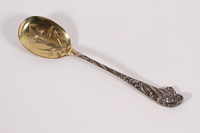
Silver ice cream spoon with floral engraving saved by young German Jewish refugee
Object
Silver ice cream spoon from a set of twelve brought by Ingrid Neuhaus, 18, when she was sent for safety from Hamburg, Germany, to Great Britain in Feburary 1939. She joined her younger siblings Annelore and Hans who had been sent on the Kindertransport in January. This set of spoons was the only valuable item she was able to take out of Germany.
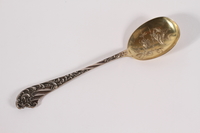
Silver ice cream spoon with floral engraving saved by young German Jewish refugee
Object
Silver ice cream spoon from a set of twelve brought by Ingrid Neuhaus, 18, when she was sent for safety from Hamburg, Germany, to Great Britain in Feburary 1939. She joined her younger siblings Annelore and Hans who had been sent on the Kindertransport in January. This set of spoons was the only valuable item she was able to take out of Germany.
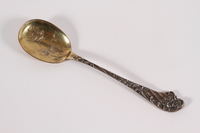
Silver ice cream spoon with floral engraving saved by young German Jewish refugee
Object
Silver ice cream spoon from a set of twelve brought by Ingrid Neuhaus, 18, when she was sent for safety from Hamburg, Germany, to Great Britain in Feburary 1939. She joined her younger siblings Annelore and Hans who had been sent on the Kindertransport in January. This set of spoons was the only valuable item she was able to take out of Germany.
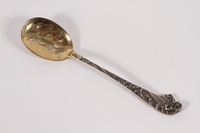
Silver ice cream spoon with floral engraving saved by young German Jewish refugee
Object
Silver ice cream spoon from a set of twelve brought by Ingrid Neuhaus, 18, when she was sent for safety from Hamburg, Germany, to Great Britain in Feburary 1939. She joined her younger siblings Annelore and Hans who had been sent on the Kindertransport in January. This set of spoons was the only valuable item she was able to take out of Germany.

